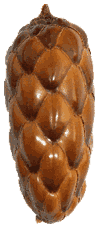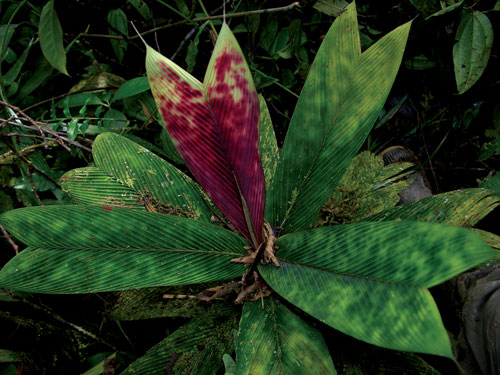 |
Palm |
 |
Palm |
 |
| Geonoma epetiolata, showing the colorful new leaf. Photo courtesy of Mario A. Blanco and Silvana Martén-Rodríguez. |
Geonoma epetiolata is endemic to Costa Rica and Panama. In Costa Rica, this understory palm species is found in the Atlantic slopes within lowland and premontane rain forest (Henderson et al. 1995). Previous herbarium collections from the 1980s showed this species located in an altitudinal belt from 400 to 800 meters above sea level, mainly in the province of Heredia. However, two very recent collections in the same area indicate two populations of G. epetiolata at 34 and 180 meters above sea level. In Panama, herbarium collections of G. epetiolata show a wide spread distribution in an altitudinal belt from 200 to 1500 meters above sea level.
Geonoma epetiolata is a slender, solitary palm (rarely clustered), usually less than 2.5 m tall, with a small stem diameter (5–11 mm). Crown is composed of 5–10 narrow, bifid leaves, with leafy rachises 30–60 cm long, lacking petioles. Leaves are unusual in their coloration; young leaves are reddish-purple below, with yellow, green, and red-purple mottling above, earning this species the name “Stained Glass Palm.” Spicate inflorescences are interfoliar, bearing small purplish-black fruits (5 mm in diameter).
Plants become reproductive at approximately 10 years of age. No nectar is produced; monoecious flowers are visited by weevils, drosophiid flies, and stingless bees, but none of these has been conclusively demonstrated to effect pollination. Rates of fruit set are low (Martén & Quesada 2001). Eastern and western populations in Panama differ in the degree of staminodial tube lobing (de Nevers & Grayum 1998). Plants are highly shade tolerant and are extremely slow growing, producing a new leaf approximately every six months (S. Martén, unpublished data). Low rates of growth and fruit set and limited seed dispersal ability contribute to the vulnerable state of the few remaining natural populations.
Habitat loss and collecting for the ornamental plant trade are the greatest threats. The condition of the population in the type locality near Santa Fe de Veraguas Panama is unknown.
In Panama, a population is protected in Omar Torrijos National Park (Blanco & Martén 2007). In Costa Rica, Geonoma epetiolata is protected in a few privately owned nature reserves and within Braulio Carrillo National Park. Illegal collecting for the horticultural trade still occurs within these areas, despite legal protection.
Robin L. Chazdon, Department of Ecology and Evolutionary Biology, University of Connecticut
Juan Pablo Arroyo, Department of Ecology and Evolutionary Biology, University of Connecticut
Blanco, M. A. & S. Marten. 2007.
The Stained-Glass palm, Geonoma epetiolata.
Palms 51: 139–146.
Henderson A., G. Galeano, & R. Bernal. 1995.
Field guide to the palms of the Americas.
Princeton University Press. Princeton, New Jersey.
Martin, S. & M. Quesada. 2001.
Phenology, sexual expression, and reproductive success of the rare Neotropical palm Geonoma epetiolata.
Biotropica 33: 596–605.
de Nevers, G. & M. H. Grayum. 1998.
Notes on Geonoma in Mesoamerica.
Principes 42: 94–103.